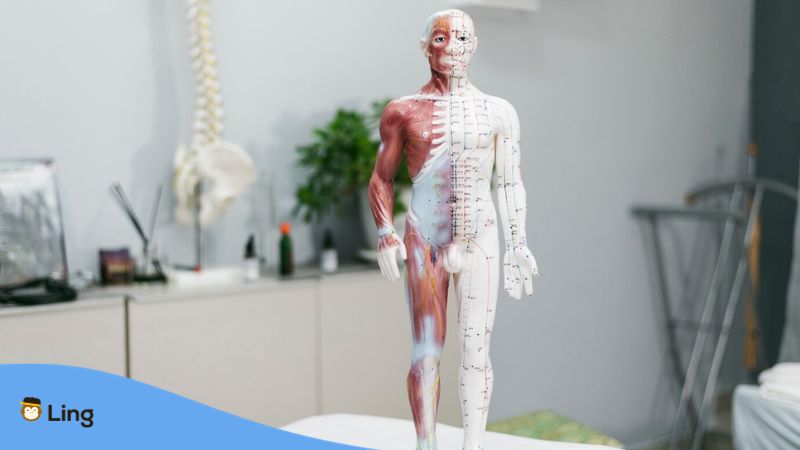Ready to speak better with the Filipinos? Today, we will learn about the basic vocabulary and expressions for different body parts in Tagalog. As the popular Filipino song goes, “Paa, Tuhod, Balikat Ulo…” there are specific words you must use so that locals can understand you immediately. Let’s learn more about this topic below!
The song mentioned above is very popular and has been part of elementary education in the Philippines. This song or nursery rhyme is used by parents and teachers so that children at a very young age can learn about the different body parts.
Fun fact: When you enter a traditional Filipino house with a child living there, you’ll typically see posters of the alphabet and the different parts of the body in Tagalog and its English translation. Interesting, right?
Parts Of The Body In The Filipino Language
To say “parts of the body” in Tagalog/ Filipino language is “mga bahagi ng katawan”. The different body parts are one of the first lessons taught to children in their homes by their parents. This makes sense because we all know the importance of learning about the different body parts and the words to use in everyday life. In this part of the blog, we will learn first about the body parts that we usually see on our faces.
Head – Ulo
Of course, the first body part is our head, or “ulo” in Tagalog. There’s this Filipino idiom that says “matigas ang ulo,” which means “hard-headed person.” They also say “mahina ang ulo” to describe a person who is not so smart.
Face – Mukha
Pia Wurtzbach, Catriona Gray, Megan Young, and Kylie Versoza are just a few Filipino women who won international pageants. This is proof that a Filipino’s face can stand out.
Today, different skincare and cosmetic products influenced by foreign countries, especially South Korea, are very popular among Filipinos, both male and female.
Hair – Buhok
Naturally born Filipino hair is black in color. But, because of modern influences, many Filipinos dye their hair in different colors, mostly brown or blonde.
Hair, or “buhok,” is a big deal for Filipinos. Their hair is usually straight, but there are also lots of Filipinos that have curly or wavy hair. There’s also this joke that the month of December is the “rebond season” because this is when people are on a break, have different parties to attend, and, of course, they have lots of money.
Forehead – Noo
When you hear the joke “airport,” this means that one’s forehead is very wide. This is a joke that I think is unique among Filipinos. Foreheads are also a big deal among Filipinos.
For men, it’s pretty okay, but for women, it’s a bit bothering. That’s why women with wide foreheads usually get bangs to hide it. Some also believe that people with a wide forehead are smart, so when someone with a wide forehead is being teased, this is what they usually say in return.
Eye Brow – Kilay
“Kilay is life. (Eyebrow is life.).” This is an expression that girls usually use to indicate how important an eyebrow or kilay is. Well, we all know how our eyebrows can change someone’s look.
Because of this, eyebrow products like eyebrow gel, pencil, powder, or pomade are really in demand. They also do different kinds of eyebrow procedures like threading or eyebrow tattoos to maintain the “Kilay on fleek. (Eyebrow on fleek)” look.
Eye – Mata
Filipinos have the typical Asian eyes or “singkit” but are not as small as Chinese, Koreans, and Japanese to the point that they want to undergo a double eyelid procedure. There are also Filipinos that have big, rounded eyes.
When it comes to idioms, the most famous one is “matang-lawin,” which describes someone with a sharp sight, like a hawk.
Ear – Tainga
If you know a Filipino parent, you have most certainly heard of the idiom“taingang kawali,” which means “an ear made of the pan.” But, contextually, it means someone pretending not to hear anything.
Filipinos typically have medium-sized ears. Back then, having ear piercings, especially for boys, was not so common. But today, many people, including men, want many ear piercings. This is probably brought by foreign influences.

Nose – Ilong
Tayo’y mga Pinoy
Tayo’y hindi ‘Kano
‘Wag kang mahihiya
Kung ang ilong mo ay pango
These lines from a traditional Filipino song tell that the real Pinoys should embrace their physical characteristics, like having a flat nose. Filipinos do not naturally have pointed noses. Having flat and big noses is one of the most common insecurities of Filipinos. That’s why many of them are undergoing rhinoplasty, a surgery to lift the nose.
Not so long ago, a Filipino TV show, “Kapuso mo, Jessica Soho,” features different Filipinos who have undergone this medical procedure to improve their noses. Although many Filipinos are insecure about their noses, there are still those Filipinos who embrace them as part of their own natural body.
Mouth – Bibig
The Tagalog word for mouth is “bibig.”This is indeed one of the most important body parts for Filipinos. Why? First, they love to eat, they are known for being some of the best singers in the world, and, of course, they are known for their sweet smiles. Of course, there are also different parts of the mouth area, which you will learn from the table below.
Parts Of The Mouth
The mouth is where we talk, eat, and smile. Let’s learn the Tagalog words for different parts inside our mouths.
| English | Tagalog | Sound |
|---|---|---|
| Tongue | Dila | |
| Teeth | Mga ngipin | |
| Lips | Mga labi | |
| Gums | Gilagid | |
| Palate | Ngalangala | |
| Tonsil | Tonsil | |
| Saliva | Laway |
Other Human Body Parts In Tagalog
After learning the different body parts found in our face, here is a list of more parts of the body in Tagalog:
Fingers And Toes
We use our fingers to hold things and our toes to walk. Find out what they’re called in Tagalog.
| English | Tagalog | Sound |
|---|---|---|
| Index finger | Hintuturo | |
| Middle finger | Hinlalato | |
| Ring finger | Palasingsingan | |
| Pinky/Little finger | Hinliliit | |
| Thumb | Hinlalaki | |
| Nails | Mga kuko | |
| Finger | Daliri |
Internal Body Parts
Inside our body, there are many parts that help us live and move. Let’s learn their names in Tagalog.
Common Words Related To Body Parts In Tagalog
Now that you have learned the different body parts in Tagalog/Filipino, let us now learn some vocabulary words related to body parts.
| English | Tagalog | Sound |
|---|---|---|
| Beautiful | Maganda | |
| Rounded eyes | Bilugan ang mata | |
| Small eyes | Singkit | |
| Thin | Payat | |
| Fat | Mataba | |
| Sexy | Balingkinitan | |
| A person who has really developed muscles | Maskulado |
You’ve now expanded your Tagalog vocabulary with words related to body parts. Keep practicing these terms, and you’ll find conversations about the body easier. Thanks for diving deep into the language with us!

Interested In Learning Tagalog/Filipino?
Talking may just require a few body parts, but making actual connections with the locals just requires your heart and soul. The country of the Philippines might be a small Asian country, but it has a lot to offer.
And the best way to enjoy your time in the Philippines is to connect with the locals. To do that, you can start learning Tagalog with the Ling app.
The Ling app is a language learning platform that helps you improve your language skills to learn your target language in record time. It will provide you with lots of activities to do.
Real language experts and native speakers develop the content of each lesson, so you don’t have anything to worry about. You can also read different blog posts to learn more about their culture.
If you’re interested in discovering Tagalog or 60+ other foreign languages, just go to the website, sign up, and start your first lesson right away. If you prefer to have the Ling app on your phone, then download the app from Google Play and App Store now! Learn more aside from body parts in Tagalog today!
Updated by: Jefbeck


















